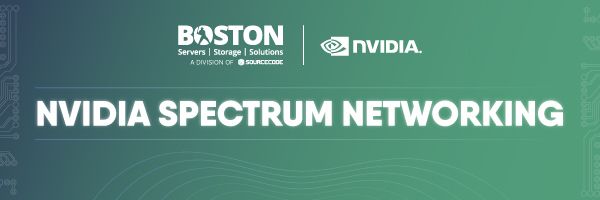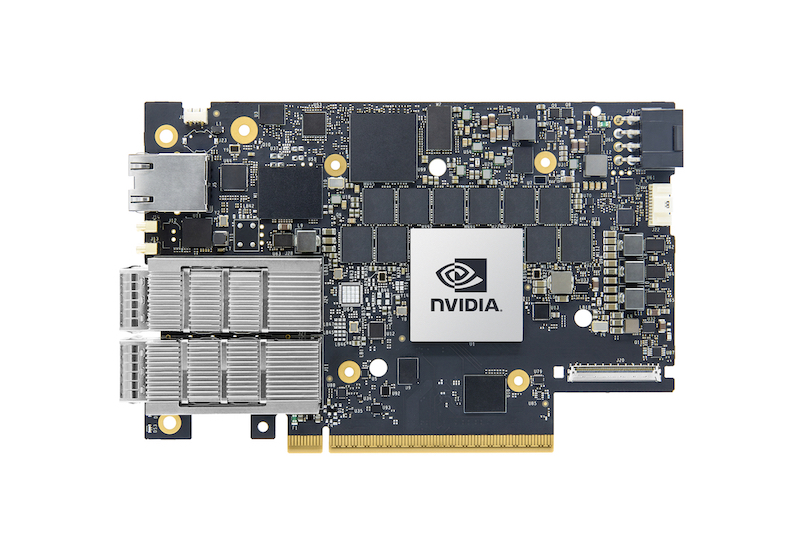
An end-to-end Ethernet platform purpose-built for modern AI data centres. Spectrum brings together high-density Spectrum switches, SuperNICs (BlueField and ConnectX families), LinkX cables and optics, and an open, automation-first software stack to give predictable, low-latency, high-throughput Ethernet at hyperscale.
Why Spectrum matters for AI
AI workloads place unique demands on networking: extremely high bandwidth, predictable latency, tenant isolation, fine-grained telemetry and tight coordination with GPU fabrics. Spectrum answers those needs by combining hardware optimisations and software features that reduce iteration times, improve throughput and simplify operations for large-scale training and inference.
Key benefits at a glance
- Purpose-built for AI fabrics: Engineered to reduce congestion and accelerate distributed training and inference.
- Industry-leading port density and speeds: 10G through 800G options for leafs and spines.
- Offload and SuperNIC acceleration: Move telemetry, security and storage off the host CPU with BlueField and ConnectX SuperNICs.
- Open, automation-ready software: Cumulus Linux with NVUE, NetQ and NVIDIA Air for validation, monitoring and closed-loop operations.
- Future-ready optics: Co-packaged optics and photonics options to reduce power and increase per-port density as AI clusters scale.

What Makes up the Spectrum Platform
Switch silicon and systems
Spectrum switches (Spectrum-4 family and Spectrum-X variants) provide the switching fabric for AI fabrics, with leaf and spine platforms that scale from 10GbE up to 800GbE per port. Typical enterprise deployments use the SN5000 series family where high-density 800GbE ports, deep buffer and large forwarding tables are critical for tenant isolation and NUMA-like performance across racks.
SuperNICs and DPUs
BlueField and ConnectX SuperNICs provide hardware offload for RDMA/RoCE, storage protocols and telemetry. Offloading reduces host CPU overhead and provides deterministic networking behaviour for multi-tenant clouds and shared GPU clusters.
Optics and cabling
LinkX optical transceivers and active cabling are validated across the Spectrum range and offer a choice of reaches and power/power profiles. Spectrum-X now includes photonics and co-packaged optics options that increase per-port density while reducing power consumption in large racks.
Software and operations
Cumulus Linux with the NVUE object model provides a declarative, API-first configuration approach that integrates with popular automation tools such as Ansible. NetQ supplies telemetry, fabric validation and troubleshooting at large scale, and NVIDIA Air provides a digital twin and simulation capability for change validation before you disrupt production.
Technical Highlights
- Switch throughput: SN5000 family devices provide multi-terabit switching capacity suitable for 800GbE fabrics and dense leaf/spine deployments.
- Port speeds: 10G, 25G, 50G, 100G, 200G, 400G and 800G supported across the product family.
- SuperNIC throughput: ConnectX-8 SuperNIC supports up to 800Gb/s total throughput, BlueField-3 SuperNIC up to 400Gb/s with hardware offload capabilities for RoCE, NVMe-oF and accelerated telemetry.
- Software: Cumulus Linux (NVUE declarative model), NetQ for observability and NVIDIA Air for digital twin validation.
Real-world use cases
Hyperscale AI training
Scale distributed training across racks while preserving predictable iteration time and minimising stragglers.
Multi-tenant AI clouds
Hardware isolation, SuperNIC offloads and NetQ telemetry help guarantee SLAs across tenants.
AI storage fabrics
Spectrum optimisations reduce congestion and improve read/write throughput for GPU-accelerated storage solutions.
Edge and telco AI
Deterministic Ethernet behaviour and NVUE automation make Spectrum suitable for edge aggregation and telco AI RAN use cases.
Deployment patterns and reference architecture
- Intra-rack fabrics: Low-latency leaf switches connected to local Spine or NVLink domains for GPU-to-GPU traffic.
- Inter-rack fabrics: High-bandwidth Spectrum spines using 400/800G ports and SuperNICs for RoCE and RDMA traffic.
- Coexistence with InfiniBand: Many AI clusters use NVLink and InfiniBand for tightly coupled GPU domains and Spectrum for storage, management and multi-tenant north-south traffic.
Why Choose Boston Limited for Spectrum Projects
- Design and architecture: We map Nvidia Spectrum solutions into your topology and provide capacity planning for throughput, buffers and QoS.
- Proof of concept: Lab validation in our test facility , including performance tests with GPU servers and SuperNICs.
- Integration and deployment: Rack, cable, optics and software bring-up, including Cumulus Linux configuration and NetQ monitoring.
- Training and enablement: Boston runs NVIDIA DLI-aligned training workshops and practical sessions in our labs.
- Support and lifecycle services: Firmware management, OS updates and spare parts planning for enterprise continuity.
FAQs
Is Spectrum only for hyperscalers?
No. Spectrum scales from enterprise clusters to hyperscale AI clouds. The key is right-sizing switches, optics and offloads to the workload.
How does Spectrum compare with InfiniBand?
InfiniBand offers lower latency for certain tightly coupled HPC workloads. Spectrum focuses on Ethernet environments and offers the benefits of standardised Ethernet, open network stacks and lower operational friction for multi-tenant AI clouds. Many customers choose both, InfiniBand for ultra-low latency GPU fabrics and Spectrum for storage, management and multi-tenant east-west/north-south traffic.
Boston test Spectrum with my GPU servers?
Yes. Our labs can run PoC and benchmark tests with your server images, GPUs and SuperNICs to validate performance and behaviour.
Specifications change over time; contact Boston Limited for the most recent datasheets and certified configurations.
Connect with our sales team today to discover how NVIDIA Spectrum Networking can transform your organisation's performance.